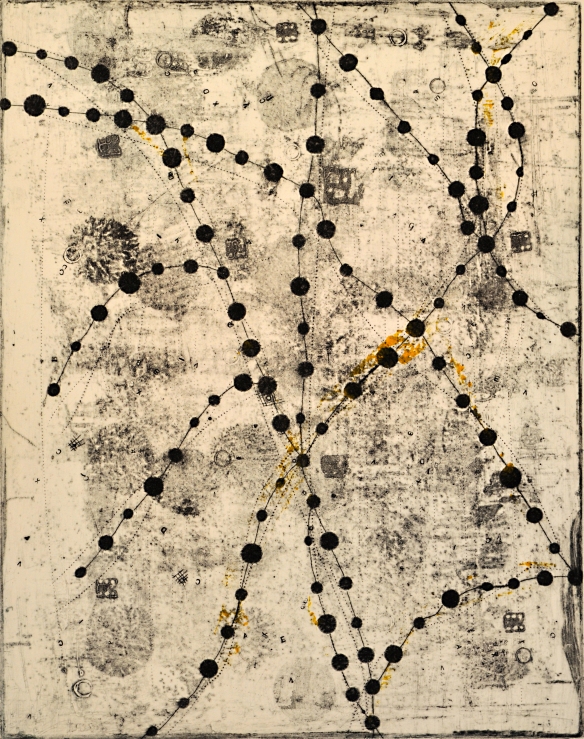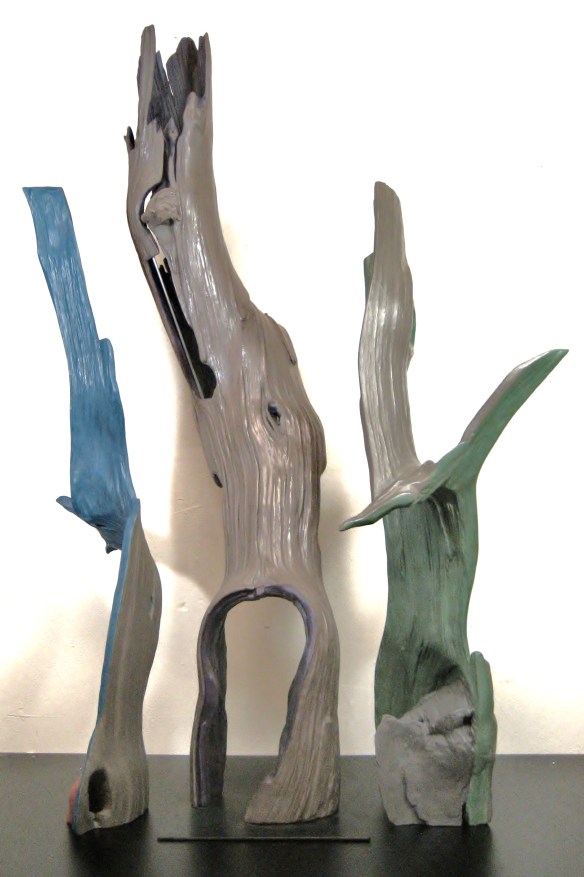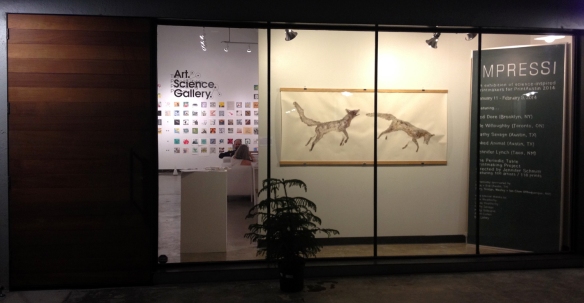I am pleased to welcome printmaker Ruthie Powers to the biocreativity blog as a continuation of the Art + Science Series. Ruthie will be joining Annell Livingston, Landry McMeans and Laura Moriarty in our GEO_____ show! Ruthie’s current work takes its cues from maps and geography.
[biocreativity] Ruthie, tell us a little bit about yourself and your background.
[RP] I am a printmaker who also creates complex surface design with dye on textiles. My art education has been pieced together over time beginning with photography and graphic design classes in the university and community college setting. I also have taken many workshops: art quilting, textile dyeing and surface design. Workshops in the last several years include a week-long Painted Intaglio workshop at Making Art Safely with Lennox Dunbar, four days with Debbie Little Wilson at Hill Country Arts Foundation and many one- and two-day printmaking workshops through Women Printmakers of Austin (Texas). Very recently, I took a 2-day workshop at Southwest School of Art in San Antonio with visiting artist Aimee Lee about hanji, the Korean paper.
[biocreativity] Here on biocreativity, we’re always curious to know, what is it about nature that inspires or excites you?
I love being an artist and am interested in science through nature. I am constantly amazed with ways nature presents beautiful designs and compositions. I enjoy learning and naturally ask “I wonder why…”. So when I am in nature I am constantly observing plants, animals, and the environment around me.
My science and nature learning usually comes when I see something that interests me that I cannot explain or do not understand. Once I planted passion vine, thinking it was so beautiful. Then I noticed the leaves were being destroyed. I was upset until I saw that a butterfly was coming often to the plant. I learned it was the gulf fritillary. More observation let me see the chrysalis, a strangely-beautiful shape hanging from the vine. With more patience, I was able to watch the female gulf fritillary place her honey-colored eggs on the passion vine plant. That was the full cycle, learned over several weeks of observation. Right now (early April in Austin, Texas) I am watching my rue plant which is larval food for the giant swallowtail butterfly or one of it’s close cousins. The caterpillars are all over the rue plant in various stages of growth.
[biocreativity] It’s great to see the ways science and art can lead to questions and then maybe provide some answers, how do you view the interaction of arts and sciences?
[RP] Both involve creativity, exploration, and observation. It is not unusual to find an artist who is interested in the sciences such as the watercolorist who paints plant life.
[biocreativity] This series seems to be inspired by more than just the outdoors, there are a lot of linear and geographical elements. What inspired you to do this series?
[RP] My current printmaking series, GeoTopo, is inspired by maps and geography both real and imagined. Living in central Texas, I have any opportunities to observe the land—the Texas Hill Country with all it’s shapes—hills, valleys, waterways, and dry creeks.
As a child, I was the navigator on family road trips so I became very familiar with map reading and symbols. I have travelled a lot and enjoy having a map to guide me as I go. I bring the maps back home to add to my collection. I also have enjoyed reading about travel and looking at landscape photos throughout my life.
One serendipitous day about a year ago, I found an Encyclopedia Britannica World Atlas from 1960 that was being thrown into a trash bin. I grabbed it and took it home. I tried doing various art projects with this oversized volume, but nothing seemed to catch my interest until I decided to create GeoTopo, a series of prints based on Map, one of my prints. The atlas then became a great visual resource. I studied it, browsing forward and back, and realized that I could use specific maps as visual models for prints. For example, the Kansas state map shows the even spacing of towns between mail stops from the days when postal service was by stagecoach. This visually translated into the Mail Stops print. I also found maps of airline flights in the atlas. This reminded me of times looking over the maps in the back of airlines magazines. So, the print Flight Paths became part of the GeoTopo series.
[biocreativity] What is the most important thing that you want others to know about your art?
[RP] Printmaking itself is a very tactile and kinesthetic experience. My whole body is involved in the process, from touching the paper, to inking the plate. All my muscles and joints are involved.
I really enjoy the process–the plate making, the adjustments to the plate while proofing, and the printing itself. I enjoy playing with the different colors of ink to see how they combine on the print to make new colors. This is a continuation of the color mixing I learned while dyeing fabric, which I have brought to printmaking on paper.
[biocreativity] Before you go, one last question. What is your advice to young artists and scientists who might be thinking about getting into art-science projects?
[RP] Take a process you enjoy and do it over and over and over. You will get unexpected results. You will find your style.
[biocreativity]Thanks so much for taking the time to chat with us! Where can we hope to see you go next?
[RP] I currently have five prints in the BioTopo series. I have at least three more in process, so I will continue with them. I am printing editions of 12 prints for each plate, so that is a lot of intense studio time.
I always have many more ideas for projects than I am able to do. Perhaps I will work with designs inspired by historical insect prints. Maybe I will work with a process I learned in a workshop that I have yet to explore. I am just not sure!
Find Ruthie elsewhere on the internet!
www.facebook.com/ruthie.powers




















